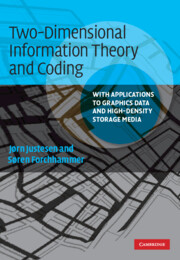 Two-Dimensional Information Theory and Coding
Two-Dimensional Information Theory and Coding Published online by Cambridge University Press: 05 June 2012
Shannon's paper from 1948, which presented information theory in a way that already included most of the fundamental concepts, helped bring about a fundamental change in electronic communication. Today digital formats have almost entirely replaced earlier forms of signaling, and coding has become a universal feature of communication and data storage.
Information theory has developed into a sophisticated mathematical discipline, and at the same time it has almost disappeared from textbooks on digital communication and coding methods. This book is a result of the authors' desire to teach information theory to students of electrical engineering and computer science, and to demonstrate its continued relevance. We have also chosen to mix source coding and error-correcting codes, since both are components of the systems we focus on.
Early attempts to apply information-theory concepts to a broad range of subjects met with limited success. The development of the subject has mostly been fuelled by the advances in design of transmitters and receivers for digital transmission such as modern design and other related applications. However, more recently the extensive use of digitized graphics has made possible a vast range of applications, and we have chosen to draw most of our examples from this area.
The first five chapters of the book can be used for a one-semester course at the advanced-undergraduate or beginning-graduate level. Chapter 6 serves as a transition from the basic subjects to the more complex environments covered by current standards.
To save this book to your Kindle, first ensure [email protected] is added to your Approved Personal Document E-mail List under your Personal Document Settings on the Manage Your Content and Devices page of your Amazon account. Then enter the ‘name’ part of your Kindle email address below. Find out more about saving to your Kindle.
Note you can select to save to either the @free.kindle.com or @kindle.com variations. ‘@free.kindle.com’ emails are free but can only be saved to your device when it is connected to wi-fi. ‘@kindle.com’ emails can be delivered even when you are not connected to wi-fi, but note that service fees apply.
Find out more about the Kindle Personal Document Service.
To save content items to your account, please confirm that you agree to abide by our usage policies. If this is the first time you use this feature, you will be asked to authorise Cambridge Core to connect with your account. Find out more about saving content to Dropbox.
To save content items to your account, please confirm that you agree to abide by our usage policies. If this is the first time you use this feature, you will be asked to authorise Cambridge Core to connect with your account. Find out more about saving content to Google Drive.